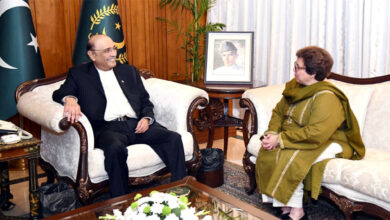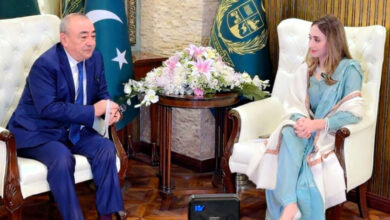سلايدر
Imran Khan Mustn’t Let Trump Make Pakistan a Scapegoat

BY SHERRY REHMAN
As U.S. President Donald Trump and Pakistani Prime Minister Imran Khan prepare to meet at the White House next week, U.S.-Pakistan ties hang in the balance. The U.S. agenda will clearly focus on countering terrorism. Equally important will be Pakistan’s key role in pushing the Afghan Taliban to reduce battlefield violence and engage in direct talks with the Kabul government, both of which are tough asks at this point. Beyond that, the politics of the visit will likely be boilerplate: Pakistan should do more to stabilize Afghanistan while also doing more to comply with global money laundering requirements and International Monetary Fund (IMF) benchmarks. If Trump is in a good mood, he may even invite Khan to dinner at the White House.
Behind the feel-good headlines associated with the visit, there are some structural realities Pakistan’s leaders must pay attention to. In American eyes, stabilizing Afghanistan is Pakistan’s only real trump card. Islamabad would prefer to have a broader relationship with Washington beyond being seen as a window into a changing Afghanistan. Yet, in international politics, hopes matter as little as intentions.
The peace talks that U.S. envoy Zalmay Khalilzad has been conducting with the Afghan Taliban and other Afghans have gone a long way toward breaking down barriers. Still, too many members of the Afghan Taliban see violence as a means of boosting their negotiating power. The irony is not lost on anyone. Once upon a time, the United States wanted to fight and talk. Now the Taliban seem to be doing so.
For its part, Pakistan has been instrumental in making the talks happen and has belatedly received some muted recognition of its unprecedented efforts to facilitate these delicate negotiations. The U.S. government’s listing of the separatist Balochistan Liberation Army as a terrorist group is one of the tokens of that recognition, as was the IMF’s agreement to lend Pakistan a badly needed $6 billion.
So, while Pakistan will not return to being the second-largest recipient of U.S. aid, a positive development that will help end structural clientelism, it’s less clear where it will stand in the next few years in relation to the United States. Will the heavy lift in Afghanistan leave its mark? Will the facts on the ground matter? The short answer to those questions is, unfortunately, no.
Indeed, if future Afghan stability is made contingent on Pakistan’s alleged good behavior, then there is still a problem. In the past, even friendly U.S. administrations would demand an explanation from Pakistan every time Kabul or its hinterland was attacked. And it was asked, without fail.
All sorts of policies were designed to change Pakistan’s behavior, but Washington ignored Islamabad’s worries. Pakistan’s hesitance in communicating its lack of control of a notoriously porous border with Afghanistan, let alone being saddled with the responsibility for large swaths of restive Afghan territory while NATO and U.S. forces patrolled the rest of the country, triggered a spiral of frustration on both sides. In rare instances when Pakistan publicly called out the International Security Assistance Force or U.S. partners for their inaction in dealing with Islamabad’s own terrorist targets, such as the Tehrik-i-Taliban Pakistan, which had a sanctuary in southern Afghanistan—the best it got was stony silence, at worst a sharp public rebuke.
The past should be a cautionary tale. Whenever Pakistan is locked into a world of back-channel diplomacy, where decisions to cooperate are often made quietly and secretively, the outcome has been suboptimal. Ever since Osama bin Laden surfaced in the Pakistani town of Abbottabad, Islamabad has remained on the defensive, systemically unable to call out its allies for not securing Pakistan’s end of an often undocumented bargain.
Whenever Pakistan’s military undertook costly operations against terrorist redoubts in its own border territories, it was left hanging. U.S. promises to help with more than a million internal refugees, displaced by joint operations on the border areas, never materialized, nor did the U.S. Reconstruction Opportunity Zones, leaving hundreds of thousands of Pakistanis homeless and restive.
Whenever there have been shared successes in the counterterrorism field—often at great cost in terms of Pakistani military lives—they rarely got a mention. The wiping out of al Qaeda from South Asia by 2012—which could have otherwise reemerged as a threat—was rarely credited to Pakistan in U.S. announcements until Pakistan’s government insisted on it.
From 2008 to 2018, Pakistan’s population absorbed the blowback from counterterrorism operations, which took the shape of spectacular retaliatory explosions and bombings that rocked Pakistan’s cities, villages, schools, hotels, and hospitals. The civilian and military death toll was upwards of 70,000 by a conservative count. As the violence waned, most of Pakistan was either confused by their U.S. allies or angry at the lack of acknowledgement from Washington.
In 2011, when up to 28 of Pakistan’s soldiers were accidentally shot and killed by U.S. forces’ friendly fire, the government shut down the NATO supply lines that cut through Pakistan, in order to extract an apology from Washington. Once it was reluctantly made by then-Secretary of State Hillary Clinton, vital communications links were restored, and U.S. air bases were closed. Pakistan was left shocked that eliciting a simple expression of regret while it mourned required such a heavy lift.
Clearly, back in Washington, there was little empathy, and even less knowledge, of Pakistan’s trauma.Clearly, back in Washington, there was little empathy, and even less knowledge, of Pakistan’s trauma. While Islamabad fought its own battle against terrorists fostered both at home and those advancing from Afghanistan, the United States simply hectored it for more action, which Pakistan had little capacity for.
As one U.S. “do more” file on Pakistan would close down, another would open, while almost no one talked up successes. This wasn’t a moral failing. In fact, U.S. officials, particularly the military, actually engaged better with their Pakistani counterparts and diplomats than many other countries’ representatives, yet as states, they seemed trapped in a cycle of cognitive disconnect.
Today, the inability of the new Pakistani government to get itself removed from the Financial Action Task Force “gray list”—a designation that deems Islamabad uncooperative—is causing it an estimated economic loss of $10 billion annually. Staying on the wrong side of such an international anti-money laundering list could pose a real danger for Pakistan.
At the best of times, Pakistani statecraft was never hardwired for change, as decades of military rule punctuated by fragile civilian governments left the civil service powerful enough to block its own reform. Today, Islamabad’s drift is even more acute as a new government flounders against formidable economic challenges, making the executive branch even less adaptive to the smart diplomacy needed for dealing with Trump’s United States. Given this history, plenty could go wrong for Pakistan if it is unable to achieve the delicate balance of using its leverage to signpost its red lines while limiting its losses.
The sobering truth is that the Taliban are under no one’s control.The sobering truth is that the Taliban are under no one’s control. Assessing success in Afghanistan’s peace process is complicated. The Central Asian-Afghanistan branch of the Islamic State has settled in and is seeking links with a resurgent al Qaeda. Both are often in combat with Taliban commanders in Afghanistan. At a tactical and political level, Iran too has amassed influence with the Taliban. Khalilzad’s talks are now viewed by policy communities from Istanbul to Islamabad as exclusively about negotiating a face-saving exit for the United States.
The agenda is actually broader, with real attempts to protect constitutional gains and other key strides made in these years, especially with respect to women. But these issues could well be abandoned in peace talks or left to local agencies to interpret as they choose. This dynamic could have its own cycle of unintended, though not unforeseen, consequences. Even if the U.S. military is less keen on rushing out than the White House-and may attempt to withdraw troops while leaving Afghanistan ridden with U.S. security contractors and spies-many observers think the country is likely to once again experience violent contests for power.
Where that leaves Pakistan is clear. The last U.S.-Pakistani joint mission in Afghanistan began more than 35 years ago. Pakistan never quite recovered from the inflow of guns, drugs, and mujahideen militants that came with the U.S.-sponsored jihad to oust the Soviet Union.Pakistan never quite recovered from the inflow of guns, drugs, and mujahideen militants that came with the U.S.-sponsored jihad to oust the Soviet Union. Today, the prospect of being left with multiple unresolved Afghan crises at its doorstep, with a sizable Pashtun population angry about a decade of military operations on its turf, is not a risk Islamabad can shrug off.
Khan needs to be able to tactfully telegraph this worry and protect Pakistan from getting caught in the crosshairs of hard new alignments in the region. The obvious structural shift that will impact the U.S.-Pakistan equation is Washington’s desire to contain China. The U.S. alignment with India is neither new nor surprising. But the recent U.S. identification of China as a strategic threat at a policy level places Pakistan in a zero-sum game, lodged firmly in the China camp with its attendant benefits and risks.
With India in the U.S. embrace, and Pakistan the new poster child of the Chinese Belt and Road Initiative, any conflict between New Delhi and Islamabad will also have higher stakes. After the February face-off at the border between the two countries, when the Indian Air Force crossed into Pakistan for the first time since 1971, a defense buildup in one country will automatically trigger anxiety in the other. On the line of control dividing disputed Kashmir, the risks of military escalation are sky high. Unless New Delhi accepts Islamabad’s offer of talks, further regional instability is likely.
Against this backdrop, with U.S.-Iran tensions on the boil, a modicum of diplomatic courtesies for Islamabad may stay on the menu in Washington, but these will have a limited shelf life if the situation in Afghanistan worsens. When the storm gathers, American anger-which is rarely based on what actually went wrong in the region-could spark fresh tensions. In the age of Twitter tripwires, facts won’t matter much.





